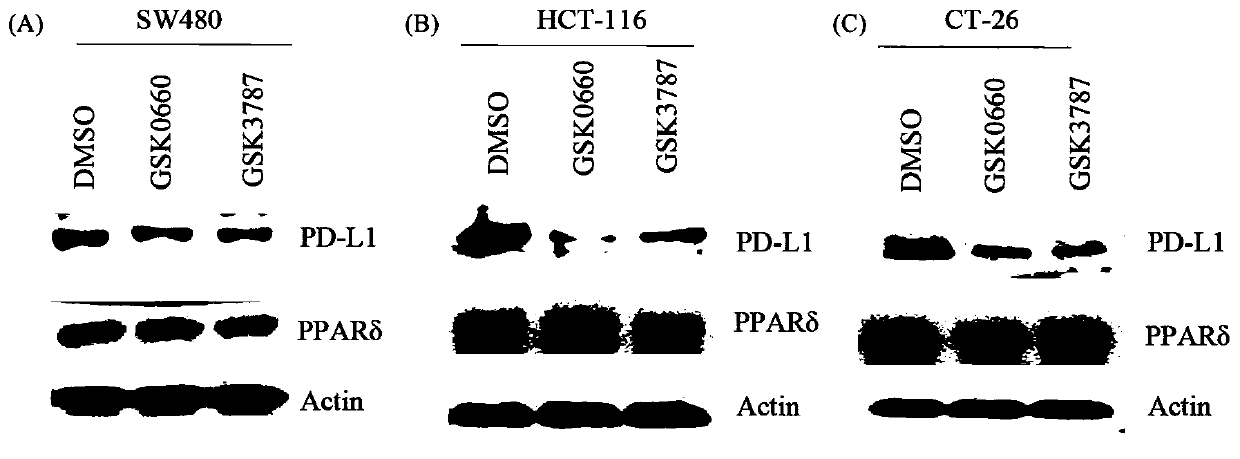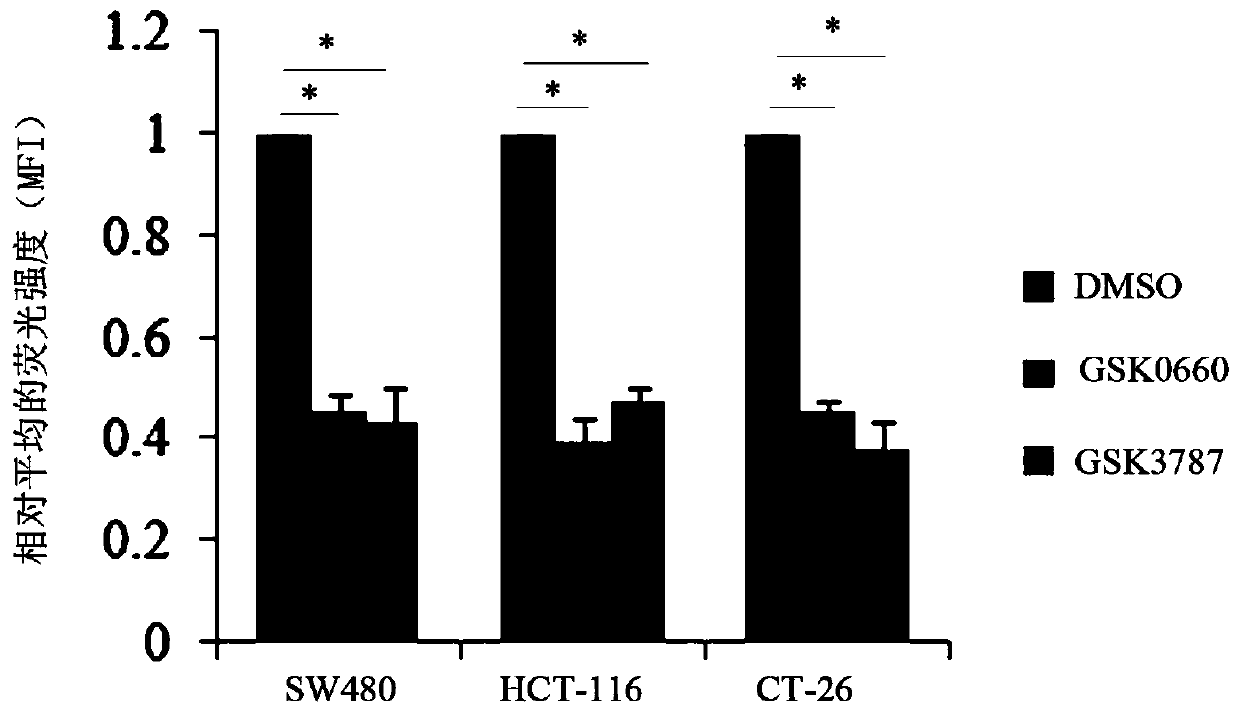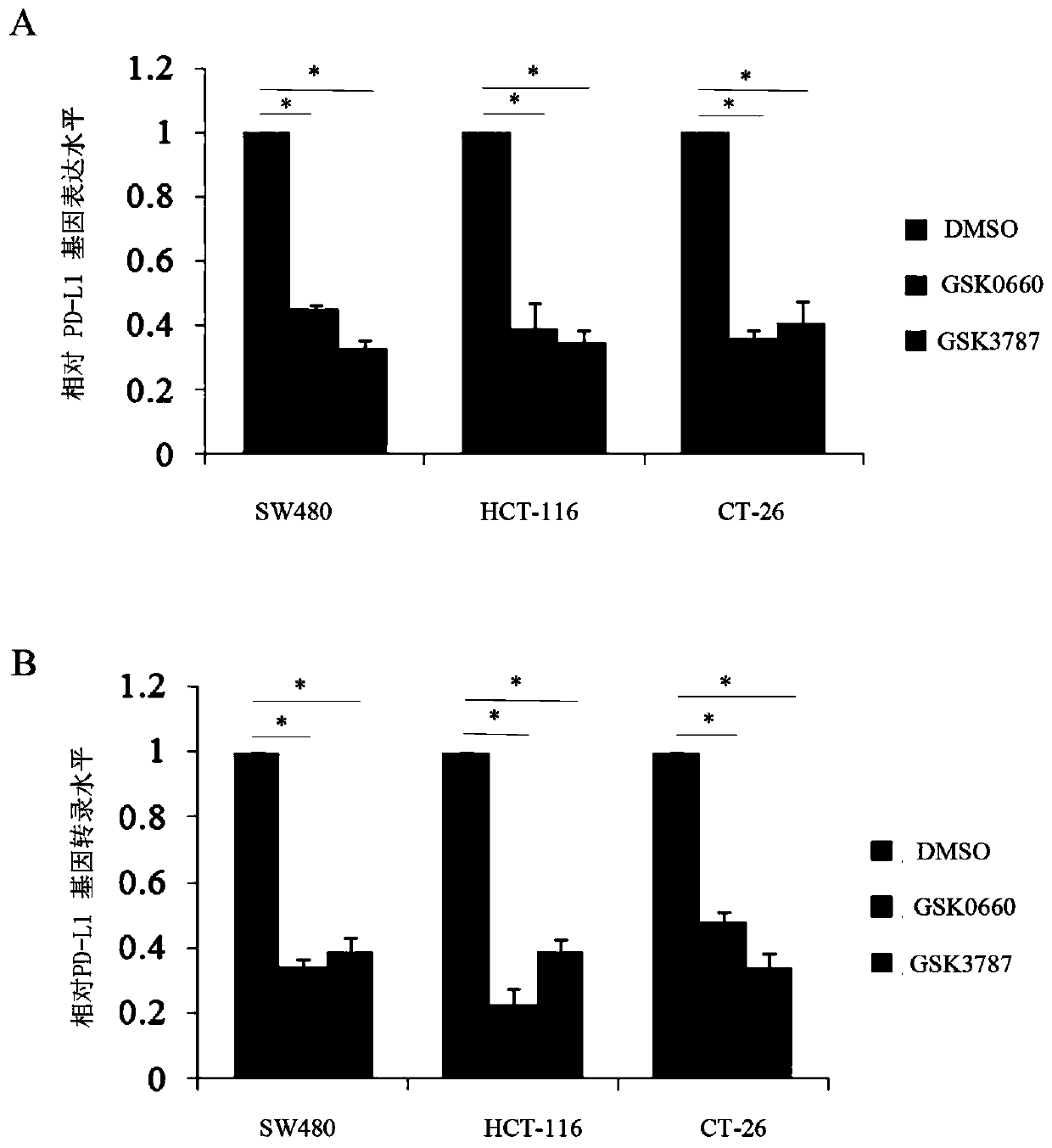Application of PPAR-delta antagonist combined with PD-1 antibody in preparation of tumor immune drug
An antibody drug, PD-1 technology, applied in the direction of anti-tumor drugs, antibodies, drug combinations, etc., to achieve the effect of inhibiting growth, inhibiting tumor growth, and increasing the effect of tumor immunotherapy
- Summary
- Abstract
- Description
- Claims
- Application Information
AI Technical Summary
Problems solved by technology
Method used
Image
Examples
Embodiment 1
[0023] Example 1: PPARδ antagonists reduce PD-L1 protein levels
[0024] In this example, the effects of PPARδ antagonists GSK0660 and GSK3787 on the protein level of PD-L1 were verified. The SW480, HCT-116, and CT-26 cells were routinely cultured in DMEM complete medium containing 10% fetal bovine serum (FBS), and when they reached 80% confluence under a microscope, they were digested with 0.25% trypsin, and the cells were inoculated in a 12-well plate at 37ºC, 5% CO 2 After overnight in the incubator and when the density reached 70%-90% of the well, the cells were treated for 12 hours with dimethyl sulfoxide (DMSO) as the control group and GSK0660 and GSK3787 as the test group.
[0025] (1) Cell lysis and Western blot analysis of PD-L1 protein expression;
[0026] (2) Collect the cells by centrifugation, filter the cells with a 40 μm filter, 2x10 5 Cells were incubated with fluorescently labeled PD-L1 antibody and incubated at room temperature for 30 minutes. Cells were ...
Embodiment 2
[0029] Example 2: PPARδ antagonists inhibit PD-L1 gene expression
[0030] In this example, the effects of PPARδ antagonists GSK0660 and GSK3787 on the expression of PD-L1 gene were verified. Routinely culture SW480, HCT-116 and CT-26 cancer cells in DMEM complete medium containing 10% fetal bovine serum (FBS), and when they reach 80% confluence under a microscope, they are digested with 0.25% trypsin, and the cells are inoculated in a 12-well plate at 37ºC, 5% CO 2 After overnight in the incubator and the density reaches 70%-90% of the well, the cells are treated with DMSO (5 μM) as the control group, GSK0660 (5 μM) and GSK3787 (5 μM) as the test group.
[0031] (1) After the cells were treated for 12 hours, the cells were lysed, and the expression of PD-L1 gene was analyzed by qPCR;
[0032] (2) The cells were transfected with the PD-L1 reporter gene plasmid, and the cells were lysed 30 hours later, and the transcriptional activity of the PD-L1 gene was analyzed with a dua...
Embodiment 3
[0033] Example 3: PPARδ antagonist combined with PD-1 antibody significantly inhibits tumor growth
[0034] In this example, the effect of PPARδ antagonist GSK0660 combined with PD-1 antibody on tumor growth was verified. CT-26 cells (2 x 10 5 ) were subcutaneously inoculated into nude mice, and the inoculated mice were randomly divided into four groups: IgG (control group), PD-1, GSK0660, and PD-1+GSK0660; IgG / PD-1 antibody (200 μg / Mice), orally administered GSK0660 (20mg / kg / day) every day. Tumor volume was measured every week for a total of 4 weeks, and mice were sacrificed by neck dislocation at the end. Tumor volume calculation formula = 1 / 2 (length × width 2 ). The expression level of PD-L1 protein in tumor tissue lysates was analyzed by Western blot, in which Actin was an internal control protein.
[0035] Figure 4 It is a graph of the effect of PPARδ antagonist combined with PD-1 antibody on tumor growth; in the figure, A is a graph of tumor volume control; B is...
PUM
 Login to View More
Login to View More Abstract
Description
Claims
Application Information
 Login to View More
Login to View More - R&D
- Intellectual Property
- Life Sciences
- Materials
- Tech Scout
- Unparalleled Data Quality
- Higher Quality Content
- 60% Fewer Hallucinations
Browse by: Latest US Patents, China's latest patents, Technical Efficacy Thesaurus, Application Domain, Technology Topic, Popular Technical Reports.
© 2025 PatSnap. All rights reserved.Legal|Privacy policy|Modern Slavery Act Transparency Statement|Sitemap|About US| Contact US: help@patsnap.com



